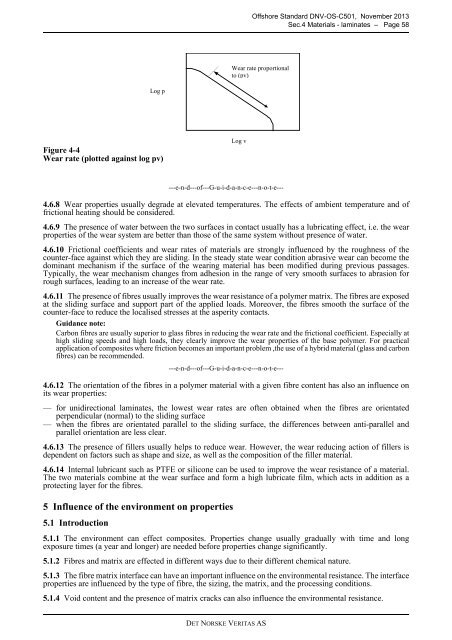OS-C501
You also want an ePaper? Increase the reach of your titles
YUMPU automatically turns print PDFs into web optimized ePapers that Google loves.
Offshore Standard DNV-<strong>OS</strong>-<strong>C501</strong>, November 2013<br />
Sec.4 Materials - laminates – Page 58<br />
Wear rate proportional<br />
to (pv)<br />
Log p<br />
Figure 4-4<br />
Wear rate (plotted against log pv)<br />
Log v<br />
---e-n-d---of---G-u-i-d-a-n-c-e---n-o-t-e---<br />
4.6.8 Wear properties usually degrade at elevated temperatures. The effects of ambient temperature and of<br />
frictional heating should be considered.<br />
4.6.9 The presence of water between the two surfaces in contact usually has a lubricating effect, i.e. the wear<br />
properties of the wear system are better than those of the same system without presence of water.<br />
4.6.10 Frictional coefficients and wear rates of materials are strongly influenced by the roughness of the<br />
counter-face against which they are sliding. In the steady state wear condition abrasive wear can become the<br />
dominant mechanism if the surface of the wearing material has been modified during previous passages.<br />
Typically, the wear mechanism changes from adhesion in the range of very smooth surfaces to abrasion for<br />
rough surfaces, leading to an increase of the wear rate.<br />
4.6.11 The presence of fibres usually improves the wear resistance of a polymer matrix. The fibres are exposed<br />
at the sliding surface and support part of the applied loads. Moreover, the fibres smooth the surface of the<br />
counter-face to reduce the localised stresses at the asperity contacts.<br />
Guidance note:<br />
Carbon fibres are usually superior to glass fibres in reducing the wear rate and the frictional coefficient. Especially at<br />
high sliding speeds and high loads, they clearly improve the wear properties of the base polymer. For practical<br />
application of composites where friction becomes an important problem ,the use of a hybrid material (glass and carbon<br />
fibres) can be recommended.<br />
---e-n-d---of---G-u-i-d-a-n-c-e---n-o-t-e---<br />
4.6.12 The orientation of the fibres in a polymer material with a given fibre content has also an influence on<br />
its wear properties:<br />
— for unidirectional laminates, the lowest wear rates are often obtained when the fibres are orientated<br />
perpendicular (normal) to the sliding surface<br />
— when the fibres are orientated parallel to the sliding surface, the differences between anti-parallel and<br />
parallel orientation are less clear.<br />
4.6.13 The presence of fillers usually helps to reduce wear. However, the wear reducing action of fillers is<br />
dependent on factors such as shape and size, as well as the composition of the filler material.<br />
4.6.14 Internal lubricant such as PTFE or silicone can be used to improve the wear resistance of a material.<br />
The two materials combine at the wear surface and form a high lubricate film, which acts in addition as a<br />
protecting layer for the fibres.<br />
5 Influence of the environment on properties<br />
5.1 Introduction<br />
5.1.1 The environment can effect composites. Properties change usually gradually with time and long<br />
exposure times (a year and longer) are needed before properties change significantly.<br />
5.1.2 Fibres and matrix are effected in different ways due to their different chemical nature.<br />
5.1.3 The fibre matrix interface can have an important influence on the environmental resistance. The interface<br />
properties are influenced by the type of fibre, the sizing, the matrix, and the processing conditions.<br />
5.1.4 Void content and the presence of matrix cracks can also influence the environmental resistance.<br />
DET NORSKE VERITAS AS



